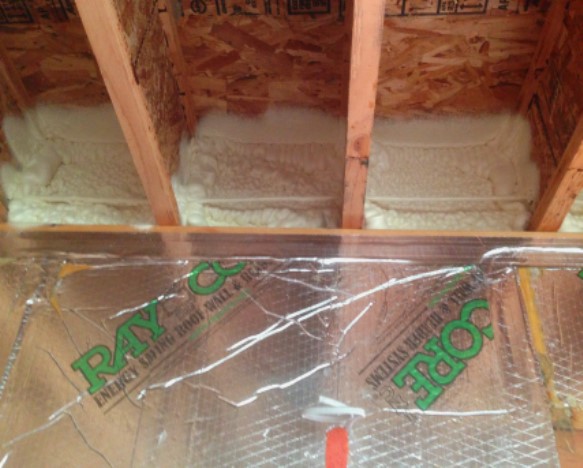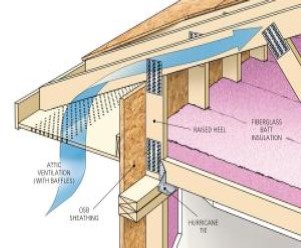RAY-CORE SIPs Best Installation Practices
A few suggested practices that can enhance the performance of your new RAY-CORE Structural Insulated Panel home...
Rim Joist / Band Joists Insulation: The only materials that likely separate the inside from the outside at the rim joist is the sheathing and the siding. Traditionally, this space has been insulated with fiberglass batts, but because fiberglass is air permeable, they do nothing to prevent warm, humid interior air from coming in contact with the rim joist, and in winter months when the rim joist is cold, condensation can cause mold and then rot of the rim joist and floor joists and accumulate in the insulation drastically reducing it’s effectiveness. Although spray foam is not a great insulation choice, it is a very good air sealer. Consider adding 2” to 6” of spray foam to each floor’s rim board and back it with and additional insulation whether it be fiberglass, cellulose, rockwool or even panel scraps to achieve at least an R-value equal to that of your walls.
Floor Insulation: Whether your foundation is a concrete slab, full basement or crawlspace, the comfort of your home will be greatly increased if your floor temperature is close to that of your living area. Floor insulation not only increases energy savings but also level of comfort. Don’t forget to properly insulate your floors!

Rafters, Trusses and Attic Insulation: First and foremost, you want approximately 25% more insulation value in your attic space than the rest of the house. If your new home includes vaulted ceilings, RAY-CORE Structural Insulated Roof Panels are most likely the perfect solution for efficiently and effectively insulating your roof with the highest R-value possible. Should your home plans specify engineered wood trusses, consider requesting raised-heel trusses. As with all modern trusses, raised heel trusses are engineered to ensure uniformity and accuracy while exceeding building code requirements. The energy savings that is gained with a “raised-heel” providing additional space for more insulation and the full depth of insulation extended to the outside of the top plate without compression. Consider, as with the rim joist, adding a few inches of spray foam at the heal for sealing. If your plans do not allow for a raised heel truss, sealing with spray foam will reduce air infiltration, transfer of warm moist air into the attic space and prevent winter condensation. Don’t forget sealing! Seal all penetrations between the living and attic space. Seal over canned lights, around ducting vents, etc.

Raised Heel Truss and Insulation
